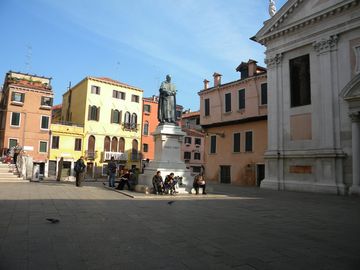

Fra Paolo Sarpi, scholar, scientist, theologian, canon lawyer and reformer, was one of Venice's greatest patriots. In fact, his firm defense of his beloved republic against the arrogance of the Pope almost cost him his life. How he survived the fifteen stiletto stabs is still today considered a miracle, if not even a sign of divine intervention.
Born in 1552 and orphaned at a young age, Sarpi was brought up by his maternal uncle, a monk, who directed him towards the Servite order. The Servite order is one of the five original Catholic mendicant orders and is devoted to preaching the Gospel and to the glorification of the Virgin Mary, especially of her sorrows after the death of Christ on the cross. Fra Paolo, as he was called after taking vows, later studied in Mantua, where he was court theologian to Duke Gonzaga. He then moved on to Milan, where he became advisor to Carlo Borromeo, one of the greatest figures of the Counterreformation. Sarpi even went to Rome and was in close contact with three successive popes, as well as with the Grand Inquisitor.
Returning to Venice in 1588, he spent the next seventeen years immersed in scientific research and theological study. He became one of the most brilliant scholars of his day, winning praise not only from his Italian colleagues, but also from many European ones. The Venetian senate wanted him to be appointed Bishop of a couple of towns in the republic, but the Vatican was not particularly enthusiastic about Sarpi's ceaseless correspondence with a few learned heretics and therefore blocked the appointment.
Towards the end of the 16th century the Vatican began exercising excessive influence over northern Italy. In 1605 Pope Paul 5th harshly attacked the Venetian Republic for the way it controlled its Catholic clergy, declaring the methods anticlerical. The Republic counterattacked. It passed a law prohibiting the Vatican from building churches or ecclesiastical congregations on Venetian territory without the consent of the state and forbidding priests or religious bodies from acquiring property. A year later the pope excommunicated Venice and lay her territories under interdict, that is, he barred Venetians from ecclesiastical functions. The pope also assembled a little army, with the help of Spain, while France did its best to solve the conflict diplomatically.
Meanwhile, Fra Sarpi, a man of the church, and one of eminent status, was defending the Venetian Republic against what he thought had been an unjust move by the pope. He lectured, wrote and published works about what should be the Vatican's limits in earthly matters. He encouraged the Venetian clergy to disregard the interdict and continue their religious functions as usual. His staunch support of Venice's secular independence from the pope would significantly alter the way catholic nations regarded the Vatican. Finally, thanks to France's diplomatic intervention, the pope lifted Venice's excommunication.
Obviously, this anti-Vatican stance earned Sarpi a lot of enemies in Rome. In 1607 the pope and his nephew, Cardinal Scipio Borghese, devised a plot to assassinate Fra Paolo. An unfrocked friar by the name of Rotilio Orlandini and his two brothers-in-law were appointed to do the job for 8,000 crowns. However, as soon as they entered Venetian territory, they were apprehended and imprisoned. Sarpi's sigh of relief was not a long one. One month later he was attacked on the spot where today stands his monument and stabbed fifteen times. Thinking that he was dead, his assassins left him on the ground and ran away. But somehow, to the wonder of all the city's doctors, the Venetian scholar survived and even joked about the unprofessional cuts by saying, "I know the style of the Roman Curia."
Fra Paolo Sarpi spent the remainder of his life in a well-guarded cloister in diligent study, research and correspondence with other European scholars. He was Venice's most cherished adviser at the time, having a say in every subject from law to history. He died peacefully in 1623, having said on his deathbed: "May she endure forever." He was talking about the republic, obviously.
The bronze monument was sculpted by Emilio Marsili in 1892. Fra Paolo appears serene and understanding, but his crossed arms imply that he does not entirely agree, and with the pamphlet in his hand is ready to substantiate his argument.
Next to the monument stands the Church of Santa Fosca, built in the 18th century on the site of an earlier church dating from the 10th century. The façade was designed by Domenico Rossi and the altarpieces were painted by Francesco Migliori.